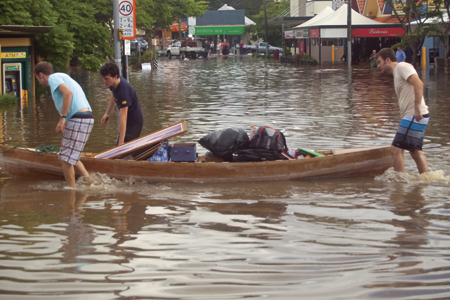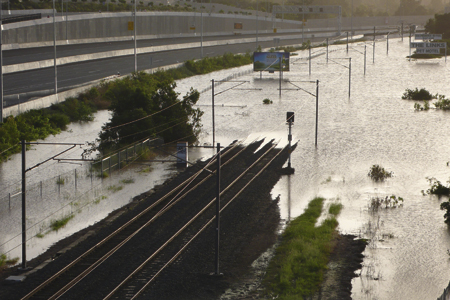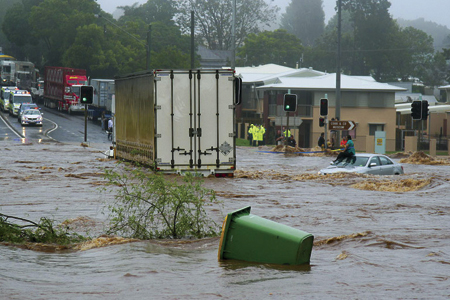
First World Floods
Issue 77 February 2011
With flood levels rising all around the world, Ali Khimji wades into the deep end to look at the cases, causes and control systems.
Whilst natural disasters are often associated with developing countries, there has been a wave of floods around the First World over the past year. Most recently, over 500 people lost their lives in a series of floods and landslides around Rio de Janeiro since the start of January; the worst natural disaster in Brazilian history.
In December, at least 70 towns and 200,000 people were affected by floods in Queensland, Australia. Haiti, having already been hit by an earthquake, experienced heavy rain from Hurricane Tomas in November, and parts of the southern town of Leogane were three metres underwater. Given that particular area was 90% destroyed in the January earthquake, it could be assumed that any reconstruction efforts have gone to waste.
September saw more occurrences with southern Mexico, Victoria in Australia, and parts of Minnesota and Wisconsin being hit. In Europe, the island of Madeira off the coast of Portugal was flooded in February, leading to the deaths of 40 people.
It is important to ascertain what the causes of these floods are. The floods above are examples of natural floods, where there is an overflow of a huge volume of water from rivers, lakes or oceans, or downpour from heavy rain, cyclones and hurricanes.

The floods in Australia were a result of the La Niña weather pattern which brought record levels of rain to the country’s eastern region. The increased rainfall is expected to run through until March.
It would have been safe to assume that developed nations would have the capacity to deal with any impending natural disasters. With the advancement in meteorological studies, scientists should be able to warn us of approaching floods and we would take the necessary precautions.
However, it appears that corners have been cut in some areas. In Rio de Janeiro, some houses were built in risky areas with no formal planning permission. It is apparent that the floods have exposed a lack of preventative action by authorities.
President Rousseff declared that the state would provide for victims, but stopping future tragedies would become a priority. “We are here to guarantee that his moment of reconstruction will also be a moment of prevention.”
The primary effects of a flood are the physical damage and any casualties from drowning. Following that, secondary effects appear where contaminated water supplies and unhygienic conditions lead to the spread of water-borne diseases. This is evident in Haiti, where there was already a cholera outbreak and the flooding intensified the effects. In addition, an entire harvest of crops can be lost, and utility supplies may be disrupted.
There are also economic and long-term effects to consider. In the Queensland floods, the estimated GDP loss is A$13 billion (approximately £8 billion). The government also has to create an emergency fund to provide for immediate relief. Flooding can change the geography of a region if river channels are altered, and farmland may be destroyed through sediment deposition.

On the other hand, there are some environmental benefits from flooding. The rushing water can carry nutrients downstream into floodplains. This is important to river ecology and agricultural production. In developing countries, farmers depend on recession agriculture; crops are planted in soils saturated by receding floodwaters.
Nevertheless, emergency teams have been working around the clock to help those most affected by the floods. In Rio de Janeiro, they are using heavy machinery, shovels and bare hands to dig through tonnes of mud and debris.
The Australian Red Cross has set up 15 evacuation centres around Queensland to house over 3,000 people. More than A$55 million (approximately £34 million) has been donated to a Disaster Relief Appeal.
It’s impossible to talk about floods in 2010 without mentioning Pakistan, where 20 million people were affected through destruction of property, livelihood and infrastructure. It was worsened by the disorganised and insufficient government response, which led to riots and attacks on aid convoys.
Two other developing nations that are currently being affected by floods are the Philippines, where half a million people have been displaced, and Colombia, where one and a half million people have been left homeless.
The unfortunate case is that these outcomes are expected in developing countries, whereas First World countries should be able to deal with these situations. Countries not yet affected, but perhaps may be, should be looking into flood control schemes now.
Netherlands, for example, have created the Zuiderzee Works, a man-made system of dams, land reclamation and water drainage works. In Rotterdam, there is even a project to construct a floating house development of 120 acres which would be unaffected by rising sea levels.
As is the situation with most humanitarian causes, we hope that the developed countries use their technology and expertise to assist developing nations in flood prevention. However, it seems to be the case that First World nations need to help themselves first.
Photography by Martin Howard and Rae Allen and Timothy
Bookmark this |
|
Add to DIGG |
|
Add to del.icio.us |
|
Stumble this |
|
Share on Facebook |
|
Share this |
|
Send to a Friend |
|
Link to this |
|
Printer Friendly |
|
Print in plain text |
|


Comments
0 Comments